What is HRMS?
A human resource management system (HRMS) integrates all of the core and strategic HR functions into one solution, improves recruiting, offers a self-service portal, automates data entry and administrative processes, streamlines information in a central database, reduces payroll and compliance errors, and facilitates data-driven strategies.
How is HRMS different from HRIS and HCM?
HRMS, HRIS, and HCM are various abbreviations used for comprehensive HR technology. These terms are often inconsistent and used interchangeably, making it easy to mix. Having said that, it’s still a good idea to know how to define it commonly. Below are the details of the units listed in each unit.
- Human Resources Information System (HRIS)-tracking applicants, employee self-service portal, central database, analytics, training, rewards, and benefits.
- Human Capital Management (HCM) – HRIS module, and onboarding and talent management.
- Human Resource Management System (HRMS) – track salaries, attendance and performance in addition to the HCM unit.
HRMS systems contain more units than any HR technology, but usually have less customization and advanced features compared to specialized programs that focus on individual units. However, HRM systems are preferred because they are an integrated system that can track employees from start to finish, from recruitment to the end of an interview.
Explore seven ways HRMS can transform your HR department.
1. Manage the recruitment process more efficiently
Previously, I wrote about the ideas that an applications tracking system (ATS) can provide.
- Find and fix hiring bottlenecks
- Find out which hiring managers need help
- Monitor recruiting team efficiency and effectiveness
- Determine the best source for recruitment
The HRMS solution does not have many special features like a dedicated ATS program, but has the advantage of retaining the applicant’s information when set up on board. You can also analyze this data to generate reports on the types of candidates who will eventually become successful employees.
2. Conduct employee on boarding and training.
Once you’ve hired the right candidates, it’s important to be busy from the start. Employees following an internal organization program are 58% more likely to remain in the organization after three years.
With HRMS, you can start moving even before new employees arrive at the office. Employees can sign management documents electronically, keep up with corporate news and business goals, and join virtual colleagues’ social networks. On the first day, you have more time to visit the property, prepare the equipment and walk.
HRM solutions can also increase participation through continuing education. For example, Millennium employees ranked training and development as the company’s most important professional interests, bypassing awards, free healthcare and retirement.
Small businesses can find rental speakers or holding very expensive physics classes. HRMS offers an inexpensive alternative with an e-learning unit, allowing employees to improve their skills and performance at their own pace.
This type of professional development not only encourages employee engagement, but also prepares future leaders in the company who may be retiring.
3. Time save with a self-service portal (SSP)
Often, employees can ask specific questions about salaries, benefits, and vacations. But answering these important and everyday questions is an important part of your day.
Through the self-service portal, employees can always access information from a remote site or from a mobile phone. Portal generally have an easy-to-use interface and employees can:
- Access their salaries, taxes and benefits
- Update their contact details and employment,
- Mark attendance and add time
- update their expense and reimbursement and Request sick leave and paid time off.
Managers can also approve and reject employee leave requests without your intervention.
Ultimately, your employees will be able to answer many of their questions at a time that suits them, and you have to enter less data, giving you valuable time to spend more meaningful activities.
4. Reducing working errors through automated processes and central database
We know how important it is to maintain accurate payroll and compliance documents. All mistakes are not only headaches, but also possible litigation.
The human resource management system automates these processes so that you do not have to worry about costly mistakes. Calculate wages and salaries, deduct the correct amount from taxes and benefits, print a check or make a deposit directly. You can also schedule reminders when commitment forms expire, requiring employees to accept digital communications and provide compliance training.
In addition, the system integrates information into a central database. You don’t have to search multiple files in cabinets, spreadsheets, or emails to get different employee details. This not only saves time and energy, but also helps to organize information and reduce errors.
5. Speed up employee performance
Employees can be more productive when they feel that work goals are aligned with their skills and that the results are rewarded correctly. However, it is not clear how employees play a role and whether they are successful.
HRMS solutions empower employees to perform on their own. You can do the following:
- Observe their own progress,
- Improve for help during a scheduled review
- Set future goals
- In response, managers can:
- Measure employee performance
- Provide better feedback,
- Choose the right assignment,
- Recognize the results,
- Create a succession plan to promote the best employees.
Overall, everyone can understand better how employees work. Managers can appreciate progress and employees will follow a clearer path





